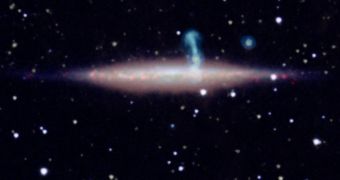Canadian astronomers at the Queen's University say that a distant galaxy featuring a massive radiation jet was finally revealed to be a poser. During a new investigation of the object, it was revealed that the jet was in fact an even more distant galaxy, located right behind the other one as seen from our vantage point in space.
In other words, the colossal jet seen in the image attached to this article is nothing more than a very distant galaxy, located around 7 billion light-years away from Earth. The galaxy in front of it, called UGC 10288, lies just 100 million light-years away.
When astronomers first imaged UGC 10288, they used smaller telescopes, so the formation appeared like a small blob in the images they analyzed. This led them to believe that the galaxy was releasing massive jets of radiations, and prompted a more in-depth study.
The new investigation made use of the Karl G. Jansky Very Large Array (VLA), a radio telescope funded by the US National Science Foundation (NSF). The datasets it produced were augmented with images taken at infrared wavelengths by the NASA Spitzer Space Telescope and Wide-field Infrared Survey Explorer (WISE) spacecraft.
In this image, VLA data appear in blue, Spitzer data in yellow, and WISE data in orange. Optical-wavelength images are coded in purple blue, while heated gas clouds within the galaxies appear in rose.
“We can use the radio waves from the background galaxy, coming through the nearer one, as a way to measure the properties of the nearer galaxy,” Queen's astronomer Judith Irwin explains.
The expert is also the lead author of a new paper detailing the findings, which was published in the November 15 online issue of the esteemed Astronomical Journal. Astronomers from the Continuum Halos in Nearby Galaxies – an EVLA Survey (CHANG-ES) consortium were also a part of the study.
By using the three telescopes, scientists were able to determine that UGC 10288's disk features an arc-like formation, which extends over a staggering 11,000 light-years above the galactic plane. This feature was confirmed by independent Spitzer observations.
WISE and Spitzer are both managed by experts with the Jet Propulsion Laboratory (JPL), at the California Institute of Technology, in Pasadena, California. The VLA is a National Radio Astronomy Observatory facility funded by the NSF.

 14 DAY TRIAL //
14 DAY TRIAL //